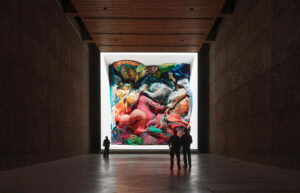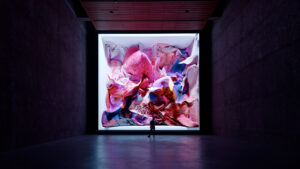
Artificial Intelligence has been around for quite a long time. Aware of not as we may be, it takes care of part of our everyday lives. We rely on machine learning for almost everything. Periodically, discussions arise and make the news worldwide about the timely questions regarding its development. Will AI ever become independent? Is it biased? Will there come a time when it won’t need human input anymore?
Over the years, we have seen the attention going to evolved specimens designed with anthropomorphic appearances to result less intimidating, the first attempts at conversations between machines, and the frenzy around projects announced by some of the big tech, racing to grab the market.
But the discussion about a future where human and artificial existences live side by side has also expanded on deeper levels. And it has also wholly entered the realm of literature, poetry, and art. With speculations that span from ethical to philosophical arguments. Does the AI replicate? Or does it create art? Can it imagine and then express itself? And is artistic creation still a human prerogative?
Can a machine….?
Among those artists working within the field of AI-generated art, Refik Anadol is a pioneer. In particular, through investigating the possibility for it to dream.
Can a machine hallucinate?
Can a machine imagine?
Can a machine dream?
 Asks the Turkish artist in his show “Nature Dream” (open until late August at ARKEN Museum of Modern Art in Copenhagen.) His digital pieces point to a future where humans and AI are even more interconnected than today. To reach that, he allows the machine to create from the enormous amount of pictures and information from the world he selects. His great scale installations – besides those currently on display in Denmark, one is visible since late December at the MOMA in New York – are a sort of response to data. With, through and because of them, the AI imagines, dreams, and hallucinates. Like the pieces of experience our brain processes while we sleep. As the artist explained once, “Every archive of memories is unique. And every archive can generate a different visualization.”
Asks the Turkish artist in his show “Nature Dream” (open until late August at ARKEN Museum of Modern Art in Copenhagen.) His digital pieces point to a future where humans and AI are even more interconnected than today. To reach that, he allows the machine to create from the enormous amount of pictures and information from the world he selects. His great scale installations – besides those currently on display in Denmark, one is visible since late December at the MOMA in New York – are a sort of response to data. With, through and because of them, the AI imagines, dreams, and hallucinates. Like the pieces of experience our brain processes while we sleep. As the artist explained once, “Every archive of memories is unique. And every archive can generate a different visualization.”
 The work “The Winds of Denmark” is emblematic in this sense. In this piece, shown in the exteriors of the Danish museum, nature and its digital interpretation are intertwined. “Fed” with meteorological data, the AI produces an ever-changing series of unexpected and unique images projected on the museum walls. The AI processes the billions of information it has been given and delivers its interpretation, a moving image that is a version of nature. Its vision of it.
The work “The Winds of Denmark” is emblematic in this sense. In this piece, shown in the exteriors of the Danish museum, nature and its digital interpretation are intertwined. “Fed” with meteorological data, the AI produces an ever-changing series of unexpected and unique images projected on the museum walls. The AI processes the billions of information it has been given and delivers its interpretation, a moving image that is a version of nature. Its vision of it.
“What if a building can dream? What if it was not only made of glass and concrete?”, Anadol asked. “If a machine can learn, can it also dream? And if it can dream, how can we visualize [this dream]?”
Fears, enthusiasm, or “utopian” view
 Many questions about how far should the development of machines and artificial intelligence go. Some fear its growth and being replaced in the workplace. Others fear being controlled or even dominated by it. Some instead are enthusiastic about the possibilities opened by crossing the line dividing the human and “synthetic” brain. Others still speculate that we are not yet at the point when machines are becoming completely autonomous.
Many questions about how far should the development of machines and artificial intelligence go. Some fear its growth and being replaced in the workplace. Others fear being controlled or even dominated by it. Some instead are enthusiastic about the possibilities opened by crossing the line dividing the human and “synthetic” brain. Others still speculate that we are not yet at the point when machines are becoming completely autonomous.
Refik Anadol belongs to the “utopian camp”, fascinated by both worlds. He takes pieces that are part of our reality (images and data), gives them to the AI, and then, through the software, he expresses himself by allowing the AI to dream. Immersed in his work, we can witness the evolution of the machine’s imagination that, similarly to what our brain does, processes experiences, visions and information and creates memories. Are we walking into a future when androids will dream (of owning) electric sheep?

***
Alley Oop’s newsletter
Every Friday morning Alley Oop arrives in your inbox with news and stories. To sign up, click here.
If you want to write to or contact Alley Oop’s editorial team, you can email us at alleyoop@ilsole24ore.com.